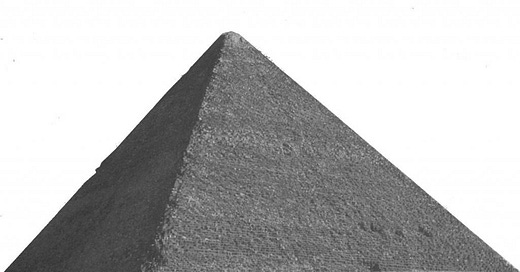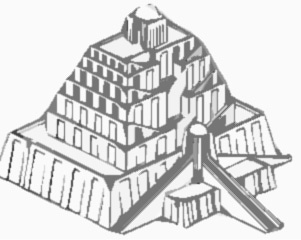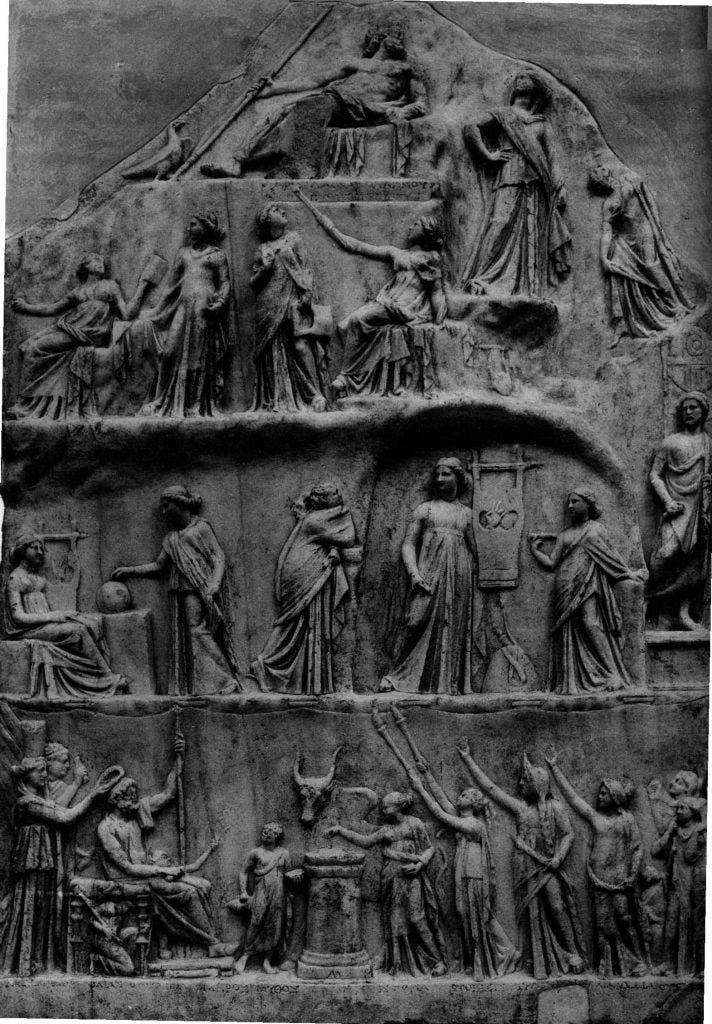The Sacred Mountain
A Newsletter based upon Chapter Five of my book The Secret Garden of the Soul – An Introduction to the Kabbalah First published by Imagier Publishing in 2008.
It is probable that the earliest system of spiritual development in Israel took the form of emulating Moses’ ascent of the sacred mountain of Sinai. This ascent is described in the Book of Exodus, the second book of the Pentateuch, which forms part of the oral tradition put into writing during the Babylonian captivity. It describes how the Jewish people, led by Moses, escaped from the land of Egypt. This narrative can be understood as a metaphor concerning the passage of the soul out of the mundane world, which signifies the body, the senses and the animal nature. thus Egypt signifies the bondage of the soul to the demands of the animal or instinctive animal nature.
The Pentateuch consists of five books that among other things describe: the creation and fall of Humanity; the wandering of humanity in the world; Humanity’s enslavement and liberation from Egypt; Humanity’s entry into the wilderness and the pilgrimage to the holy mountain; Moses’ ascent of the holy mount; the covenant between God and humankind; the re-alignment of humankind with the divine law; Humanity’s entry into the Promised Land.
Creation may be understood in metaphorical terms as the creation of the human soul, an immortal being whose only vesture is a garment of pure spirit, or perhaps of light. In this state the soul exists within the presence of God (Paradise), all needs fulfilled by that divine presence. Here time and space have no place; all share in the unity and omniscience of God. The ‘Fall’ is a descent into the material world of duality and all that such implies, where the soul experiences birth and death, pain and suffering, the imperatives of the flesh, and the need to work to survive; but above all, the soul suffers the separation from the presence of God and the darkness of ignorance that comes with it. In its fallen state, the soul knows nothing and has nothing, other than what the senses show and bring to it. Thus it engages with the world and perceives via the senses, and in which it is driven by the incessant demands of the animal nature of the body. Consequently the wandering of the people of Israel in this world as described by the Pentateuch, conveys the soul’s growing awareness of the transient nature of the world and the discovery of the means by which it can be restored to its former glory.
This animal or instinctive nature is by and large an unrelenting taskmaster and is symbolically represented by Egypt (the world) and Pharaoh, (the personality) as an embodiment of our appetites. Thus the destiny of the soul would be irrevocably fixed if it were not for the influence of the divine through the agency of Moses. Moses represents the human will touched by the heavenly realm – inspired by the presence of God (see burning bush). Thus inspired the will is able to comprehend the limitations of the world of the senses and overcome the instinctive nature (Egypt & Pharaoh), and gather his people (faculties) and withdraw them out of the immediate sphere of the instinctive nature.
The wilderness is a vast place existing neither in heaven nor on earth. It is the great unknown that must be traversed and is variously described in many of the great epics, quests and journeys from Gilgamesh to the present. To the soul the wilderness is a vast astral region that is accessed when it begins to leave the world of the senses – it is a world wherein many lose themselves. However, those who turn to God do find a way. Such people are guided, as were the people of Israel led through the wilderness (by a pillar of fire by night and a pillar of smoke by day) to the holy Mount Sinai.
A mountain signifies a high place in consciousness; such heights are not to be understood literally but metaphorically, for they represent levels of consciousness not available to the sense-bound soul. In comparison the wilderness is a low place in consciousness extending to the four points of the compass – north, south, east, and west – which is an emblematic representation of the world of the senses, in that although it ranges infinitely far and wide, it has no height, for the heights are traditionally symbolic of the heavenly realms. Mount Sinai, then, represents an elevated place of consciousness to which the soul must ascend if it is to have any possibility of spiritual regeneration.
If I may digress: the ascent of the Holy Mountain is an ancient motif that has been used by many cultures to describe the interior work of spiritual development. In ancient Egypt it was represented by the Pyramid, which is a symbol of the sacred mound that emerged out of the primal waters of Nut at the beginning of Creation, and upon the apex of which perched the phoenix, the symbol of life and regeneration.
In ancient Mesopotamia, the ziggurat, a stepped pyramid, was a formal representation of the sacred mountain. Known as the ‘House of the Shining Mountain’, the form of the ziggurat varied from three to seven platforms. Each of the platforms of a seven stepped pyramid was dedicated to a planetary deity. Complex rituals evolved around the ascent of these platforms as the ziggurat itself was a representation of the cosmos and the abode of the gods, the summit itself being the place where one communed with the supreme deity.
Many cultures have expressed their concept of spiritual development in the form of the ascent of a Holy Mountain. Mount Olympus the home of the gods of the ancient Greeks, Mount Kailash, also known as Mt. Meru, located in the Himalayas, is sacred to the followers of the religions of Bon, Buddhism, Hinduism and Jainism. Hua Shan, arguably the most sacred of the holy mountains of China is sacred to the Taoists and has been a place of pilgrimage for several millennia. The following illustration depicts the Holy Mountain mapped onto the Human (subtle) body, and suggests a psycho-spiritual understanding of the Holy Mountain.
This same principle may be seen expressed in a stone carving of Mount Olympus. It depicts the progression of the soul, from the ground upwards, in the form of a sacred rite.
In our own culture it is to be seen in various works such as that of Hildergard of Bingham who depicts the Holy Mountain as a place of inspiration, thus:
In more recent times, the Rosicrucians and the Freemasons have each in their own way defined the sacred Mountain as a means of spiritual development/ascent. The Rosicrucian Holy Mountain, as described in the following illustration, is clearly a symbolic representation of what lies before those who would aspire to the spiritual crown. As with all Rosicrucian mysteries it is expressed through Alchemical, Astrological and Kabbalistic symbols.
The Freemasons, appear to have constructed their concept of the Holy Mountain along Rosicrucian lines, albeit on their own terms, thus, the depiction of the Holy Mountain, as described in the following image, is based purely upon terms that are masonic; nevertheless, the depiction remains true to type and is relatively easy to recognise the different worlds and the labours involved therein. End of Digression…
Thus it is written that Moses (the will) is called by God (inspired) to ascend the mountain (to the heavenly realms); a narrative that among other things describes the evolutionary necessity of the soul to ascend beyond the realm of the senses, beyond the realm of the imagination, and even beyond the realm of abstract thought, before it becomes aware of the presence of God. However, Such an undertaking also requires a realignment of the soul with divine law (A new covenant), a realignment that moves from not only following the ‘letter’ but towards understanding the ‘spirit’ of the law — the Torah — for only then will it be able to enter the presence of God, the Promised Land, and fulfil its destiny.
The Tree of life is a later development of the concept of the Holy Mountain, which lends itself easily to the progressive stages of ascent and descent. Once spoken only in whispers within the confines of the sanctuary it is common knowledge today. Whether we think of it in terms of the four worlds Assiah, Yetzirah, Briah and Atziluth and all that such implies, or as a ladder formed by various permutations of the ten sephiroth, the ascent is more easily defined and understood.
This is, broadly speaking, a Kabbalistic interpretation of the human condition set out in the Pentateuch. Kabbalistic thought explores the deeper meaning of the Pentateuch, at the heart of which lies a teaching concerning the soul’s path to freedom from the influences of the mundane world. It is a path that is an interior journey into the depth of one’s being; it is a difficult journey full of pitfalls, yet, when all is said and done, it is a path worth following, for at its terminus lies the emancipation of the soul …
To know more about the author see: http://bit.ly/2NMyRk3
To read more about The Secret Garden of the Soul, see: http://bit.ly/2QSBZLB
Tagged abode of the GodsAlchemicalanimal natureascentAstrologicalAtziluthBabylonina CaptivityBook of ExodusBriahBuddhismburning bushcosmosCreationCreation and fall of humanitydivine lawEgyptFreemasonsGilgameshheavenly realmsHildergard of BinhamHimalayasHoly MountainHua Shanhuman soulisraelJainismKabbalisticMesopotamiaMosesMount KailishMount MeruMount SinaiParadisePentateuchPharaohPheonixPillar of FirePillar of Smokepresence of GodPrimal Waters of NutPromised landpure spiritPyramidRosicrucianismsanctuarySpiritualsupreme deitythe FallThe Secret Garden of the SoulTorahTree of LifeWildernessYetzirahZiggarut







